Eclipse Preparations
2017/04/04. The calendar is like an odometer. Now that the numbers actually say "2017" I think it's time to get more organized about the eclipse preps I've been doing for years. Years, I tell you.
There's still time to work out and refine the highly esoteric stuff. Exact siite selection can and will wait till the weekend before the show. That said, I have firm plans to be in Dubois, Wyoming, the Thursday and Friday before Monday, August 21's, total eclipse, with a full tank of gas and some reliable weather apps on my phone and computer, the better, of course, to head east or west as the weather wills.
There's also the need for a solar filter for the telescope so I can watch and shoot the partial phases and focus like a demon in the minutes before totality. And that's what today's project was all about.
Everyone who ever attended a Presbyterian Sunday School knows that all decent projects begin with a Quaker Oats box. This one is no different. I discovered some weeks ago that the lid to the standard tubular oatmeal box is a perfect, press-on fit for the dew shield of my TMB92SS. Not just any oatmeal box will do. It must have a plastic lid, not cardboard or paper. I had to thump a few to be sure of the materials.
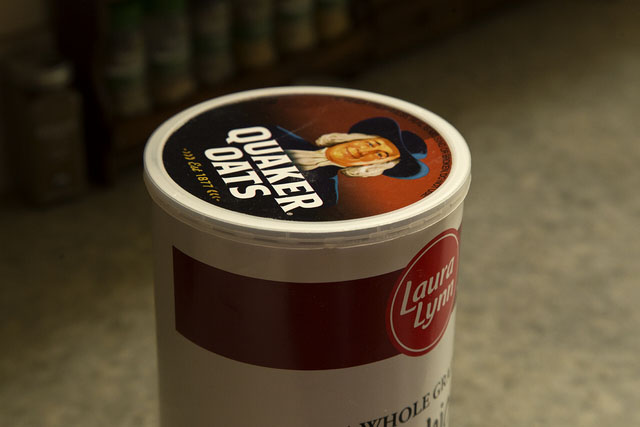
I removed whatever paper originally adorned it. There was an oatmeal cookie recipe glued to the underside of the lid, which I saved after I removed it.
A circular aperture in the lid is called for. Not too big (which wouldn't leave much plastic to which to attach the filter material) and not too small (which would throw away the use of telescopic aperture for which I have paid dearly). It needs to be circular because any other shape has corners and corners make diffraction spikes and diffraction spikes scatter light and scattered light is bad in almost any photography but it's especially bad if you're trying to make high contrast images of a ball of insane thermonuclear fury with a planet-sized rock passing in front of it.
To cut a circular aperture in the plastic lid, use a circular die. A Ball jar ring will do. Heat it up. A lot. Then center the ring on the plastic and press it down over a chunk of thick aluminum stock (to keep from cutting circular holes in countertops, for example). Voila: a circular aperture.
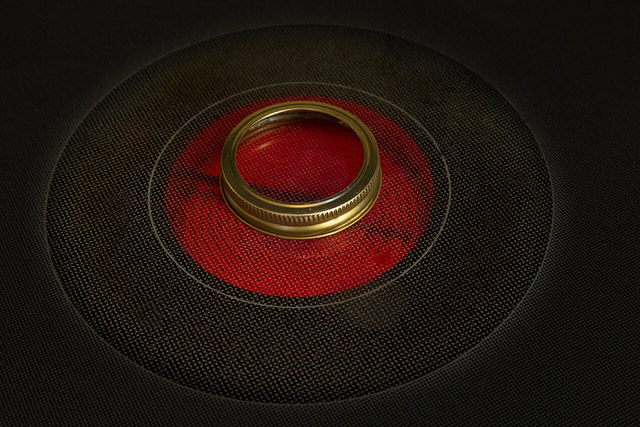
I covered the remaining plastic with black tape and touched up the still-not-covered bits with black paint (I put tape on both sides and dabbed paint on the outer side, but rationales differ; just make sure it's blacked out and that the inner side will accept adhesive to hold the filter material).
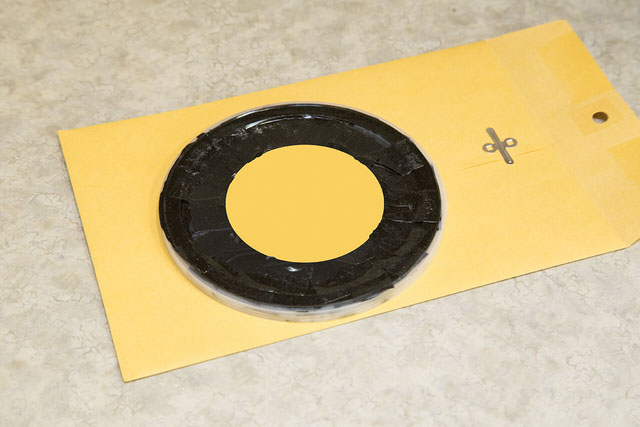
Now stop calling it an oatmeal box lid. It's now a filter cell. I taped the filter material (I'm using a 2.5-inch square of Baader Astrosolar film) to the inside of the filter cell. I took seriously the words of the prophet not to stretch the film but to leave it loose and slightly wrinkly. I may have overdone the wrinkly, but too loose is better than too tight. Yeah, the tape encroaches just a tidge on the obsessively round aperture. There are limits. I can live with that insult to my obsession.
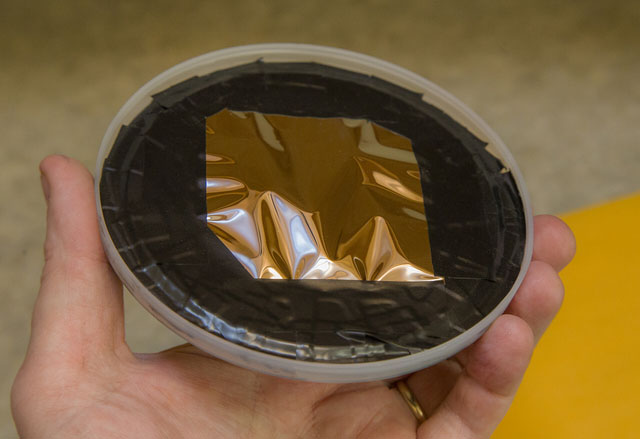
Outside, on the telescope, I shot test frames to make sure the contrast is good and to determine what exposure to use for the partial phases. The exposure for the partial phases will be the same as for the un-eclipsed Sun of course, so figure it out now. There'll be plenty to think about on eclipse day.
And note that the sun's image through Baader Astrosolar film is blue. Robin's egg blue fergodsake. I am old-school about this. The sun's filtered image is and of right must be yellow, maybe even orange, as Thousand Oaks Optical's glass filters have always made it. A yellow solar image was good enough for Paul and Silas, and it is good enough for me. It is good enough for you, too. Photoshop can make right that aspect of the world.
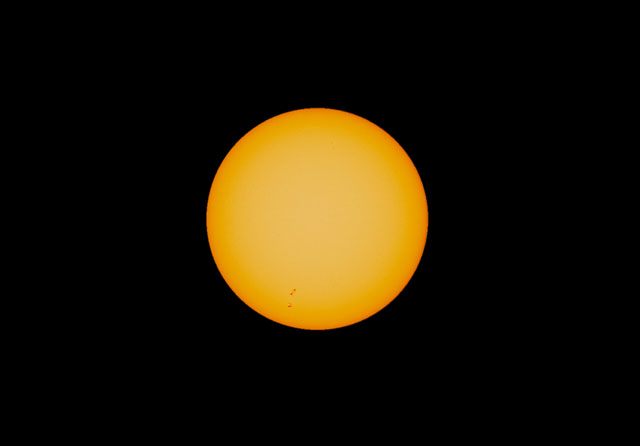
In my TMB92SS with TeleVue 0.8x compressor and flattener, 1/4000 second at ISO 400 or 800 will do just fine. It over-exposes an 8-bit JPEG image, but I'll be shooting RAW and the proper exposure (one that shows sunspots, limb-darkening, etc) is well within the range of correction. I aim to use ISO 800 for totality, so just go with that. That's one fewer setting to adjust in the heat of the moment.
The filter peels off the telescope easily enough -- as it must in the last minute before totality, without distrubing aim -- and I don't believe an errant gust of wind has any chance to dislodge it. Would I use this for a Sungazing Event where 50 elementary school hooligans are looking through my telescope? No, I would not. Under those circumstances, I would tape the sucker on and put a pipe-clamp around it. But will this work in the wilds of the west as the shadow of the Moon bears down? Will it let me get good photos of the partial phases and keep me from putting my eye out with a blast of amplified sunlight no matter how excited I might get? I say it will.
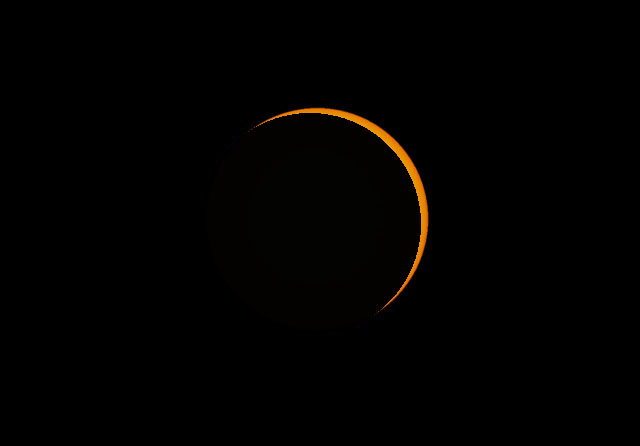
Where has the time gone? Three minutes to totality! Just kidding. The previous image Photoshopped as a reality check.
6/13/2017. I'm going to use the AT65EDQ for video. So I made a filter for it, too. I turned the threads off the inside of a peanut butter jar lid which let it slip over the dew shield of the AT65EDQ nicely, added a layer of black tape around the dewshield for a snugger fit. Then I used the lathe to cut out a ~50mm hole in the lid, coated the annulus with contact cement, set it down on some AstroSolar film, then trimmed the film close. Cut "tabs" in the hanging-over bits of the film, folded them down over the outside of the lid (now "filter cell") and wrapped the outside in more black tape. There. Just the ticket.
Next, I'll deconstruct one of the 20 pair of eclipse glasses I ordered from Amazon to make a filter for a small finder-scope. Mount that between the AT65 and the TMB92 on the dual-scope Losmandy plate, and voila! Let's go eclipse-hunting. Pix to follow. Probably when I do a reality check kit assembly in July to insure that all the cables and counterweights are in hand.
My deep-sky photos are made with a variety of sensors and optics. Deepest images usually come from a SBIG ST2000XM CCD behind a 10-inch Astro-Tech Ritchey-Chretien carried on an Astro-Physics Mach1GTO. The CCD is equipped with a CFW-10 loaded with Baader wide- and narrow-band filters. Camera control and guiding are handled by Maxim DL 5.12. A Canon 6D and a modded 50D find themselves mounted behind an Orion 10" F4 Newtonian or a 92mm Thomas Back refractor or a tiny but mighty AT65EDQ refractor, sometimes with Backyard EOS in control and PHD Guide keeping things on target. Really widefield photos are often made using the 6D and various camera lenses and an iOptron Skytracker mount. PixInsight does most of the heavy lifting in post-processing — alignment, stacking, gradient removal, noise-reduction, transfer function modification, color calibration, and deconvolution. Photoshop along with Focus Magic and a handful of other plugins get their licks in, too, especially when polishing for the web.
:: top ::